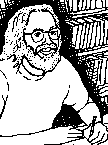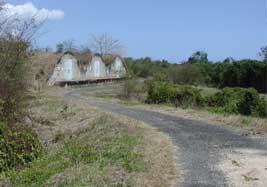
 |
One of the abandoned ammunition bunkers on the island. |
Vieques three years later
by Marc Becker
March 29, 2006
Just before midnight on May 1, 2003 activists broke down the gates to Camp García on the small Puerto Rican island of Vieques and reclaimed the land for the civilian population. Since World War II the U.S. Navy had used this Caribbean paradise as a practice bombing range, including firing napalm and depleted uranium shells that left the island heavily polluted. After decades of the growing intensity and pressure of nonviolent protests, the navy turned the land over to the Department of Interior’s Fish and Wildlife Service to form the Caribbean’s largest wildlife refuge. Almost three years later, however, the island remains much as how the Navy left it.
The navy presence on Vieques dates back to 1941 when the military acquired the land with the desire to develop a Pearl Harbor-type base for its Atlantic fleet. The military exploited Vieques for a variety of exercises including ship-to-shore and air-to-ground target practice, rehearsal of amphibious landings, and the storage of ammunition. The navy displaced poor sharecroppers and rural workers who had labored in a struggling sugar cane industry to a narrow six-mile wide strip of land in the middle of the island. The heavy bombing of the island, including the use of napalm, armor-piercing depleted uranium shells, and other experimental weapons, left the island heavily polluted with arsenic, cyanide, lead, mercury, antimony, uranium, and other toxins resulting in a cancer rate 27 percent higher than the rest of Puerto Rico. With few economic opportunities, Vieques became the poorest municipality in Puerto Rico with the colony’s highest unemployment and infant mortality rates.
Under military occupation, Vieques developed social conflicts typical for communities next to military bases, including problems with prostitution and drunken brawls. Navy maneuvers disrupted fishing around the island, and noise from bombs and low-flying airports disturbed inhabitants. Plans in the 1960s to expropriate the entire island and expel the entire population led to a round of mass protests. In the late 1970s, Vieques fishermen blocked military exercises leading to dozens of arrests and the unexplained death of Ángel Rodríguez Cristóbal in his prison cell in Florida. On April 19, 1999, two off-target bombs destroyed an observation post killing David Sanes Rodríguez, a civilian employee. Incensed with the navy’s refusal to investigate the incident or punish those who killed Sanes, thousands of people committed acts of civil disobedience that four years later finally forced an end to the bombing.
Vieques inhabitants often feel as if they are a colony of a colony. After the 1898 war with Spain, the United States government took control of Puerto Rico. Although the residents of Vieques (like all of Puerto Rico) became U.S. citizens in World War One so that the military could draft them to fight in Europe, they cannot vote for president nor do they have any voice in Congress. Puerto Rico is currently an “Estado Libre Asociado” (literally “Associated Free State,” but defined by the U.S. as “commonwealth”), which means that it is an “unincorporated territory” that “belongs to, but is not part of” the U.S. This leaves Puerto Rico subject to the whims of the U.S., and the residents of Vieques with no legal avenues to address the evils committed against them. It was this political subjugation that allowed the bombing to continue for so long.
Inhabitants of the island emphasize that ending the naval bombing was an important step, but not a final victory. A military presence still persists on Vieques, most notable a Relocatable Over The Horizon Radar (ROTHR) installation used to monitor drug traffic in the Caribbean. Rather than return the land to the people, the navy handed it over to the Fish and Wildlife Service continuing the federal government’s large and heavy-handed presence on the island. Sixty years of bombing has left the island heavily polluted, and it will take years and extensive resources to decontaminate it. Estimates for cleanup range as high as $450 billion, which represents one year of the Pentagon’s budget. Using the land as a nature preserve rather than for human inhabitation only requires a superficial cleaning, leading to fears that the military has no intent to clean up the mess.
Ironically, many of the most bitter opponents of the navy’s bombing of Vieques also recognize the benefits which it brought. Unlike the surrounding islands of St. Thomas and St. Croix, Vieques has not been overrun with large-scale capital-driven tourism projects, leaving the island with the appearance of a much more pristine environment. This presents both opportunities and challenges. Activists want to avoid land speculation and instead create a democracy that fosters sustainable development based on community needs. Ending the bombing was an important and historic victory for Vieques, but much work remains to be done to clean the island and to develop viable and sustainable economic development plans.